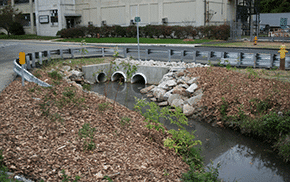One crucial decision during Connecticut Wetlands Planting is choosing the right plant. When restoring or planting in a wetlands area for the first time, it is important to choose native species. While excess moisture would kill many non-native trees, shrubs, and flowers, native plants have adapted over time to thrive in these specific wetland ecosystems. They provide food for wildlife, help prevent run off, and aid in erosion control with their deep root systems.
Plants to Choose for Connecticut Wetlands Restoration
Every native species have their specific benefits. Below are a few hardy native species commonly considered for wetland planting in Connecticut and throughout New England. These choices not only look attractive, but help to maintain the environment as well.
| Plant Name | Benefit |
| Red Maple | Vibrant, Fall Color |
| Pin Oak | Vibrant, Fall Color |
| White Cedar | Distinctive, Narrow, Tall Shape |
| Silky Dogwood | White Flowers in the Spring, Food for Wildlife |
| Large Cranberry | Food for Wildlife, Evergreen Foliage |
| Low or High Bush Blueberry | White or Pink Flowers in Spring, Food for Wildlife |
| Virginia Spider Wort | Long-lasting Purple Spring Flowers |
| Cinnamon Fern | Attractive Fronds |
| Cattails | Interesting Winter Appearance |
| Joe Pye Weed | Pink and Purple Flowers in the Summer |
Invasive Species Control and Removal
Some plants, even some seemingly innocuous plants, should be avoided at all costs. These invasive species can spread and choke out other wetlands vegetation in Connecticut, disrupting the fragile ecosystem. Most of these non-native plants arrived via boats, ships, and trains from other areas and are prohibited by Connecticut state law. The Connecticut Department of Environmental Sciences has identified a full list of invasive plants that need to be avoided at all costs.
The removal of existing invasive species can be difficult. The proper invasive species removal procedure depends on the type of plant and how it propagates. Plants that spread via rhizomes are best controlled by digging up all of the rhizome pieces as even a small segment can eventually grow into a full stand of plants. Underground barriers are also helpful in preventing the spread of rhizomes.
Plants that spread via seed are best controlled by cutting down the plant before the seed pod has had a chance to form, usually in the late spring or early summer.
Conclusion
Wetlands mitigation and keeping the Connecticut environment healthy requires effort from all of us. Knowing which plants are best suited to our fragile wetlands ecosystem (and which are not) is the first step to keeping our state beautiful for generations to come.
All Seasons Landscaping has all of the skills, experience, and knowledge to solve your wetlands planting problems on the toughest projects. Follow the button below to talk to us about your project.









